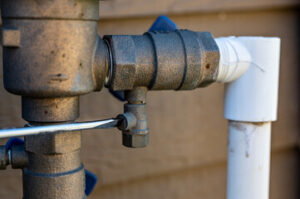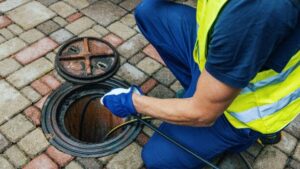A backflow preventer device is designed to keep your home and business safe. It also ensures that contaminated water can’t make its way into the municipal water supply.

If this does happen, diseases like typhoid and dysentery could spread through the community. That’s why yearly backflow testing is so important. Visit https://tidalplumbingnyc.com/ to learn more.
A water pressure test is an important part of backflow testing. This is because it can help to determine whether a device is functioning correctly. During the test, a plumber will close and open valves on the device while monitoring gauges for changes in pressure. If a problem is detected, the plumber can then fix it. Ideally, the plumber will also check for leaks in the system while doing the pressure test.
A backflow preventer is a device that ensures that the water in your home or business flows in one direction. While most people associate them with fire protection systems, they are also used in residential plumbing systems. They are vital for ensuring that your water is safe and clean. However, just having a backflow preventer is not enough – it must be tested and certified regularly to ensure that it works properly.
The State of Minnesota requires that high-hazard devices be tested annually, while low-hazard devices must be tested every two years. In order to perform these tests, a plumber must be a licensed backflow tester.
In order to properly conduct a backflow test, the plumber will need to shut off your water service temporarily. Then, they will connect a special test kit to the backflow preventer and watch for pressure changes. This is a process that can take about 30 minutes to complete. Once the plumber has completed the test, they will reconnect your water service and fill out the required paperwork.
Backflow testing is necessary because it prevents contaminated water from back-siphoning into the public or customer potable water system. This is a huge concern because it can make your water dirty and unsafe to drink. This is why you should never skip backflow testing.
It is best to hire a professional company like Kiddco Plumbing Inc for your backflow testing needs. They will handle the temporary disconnection of your water service and can also submit your results directly to the city.
Valve Inspections
Valve inspections are part of backflow testing and are used to ensure that all valves are functioning properly. They include a review of the valve’s response time, control signal, and shut-off capability. It is important to perform these inspections because they can help identify potential issues with your water system.
A valve inspection can be done in many ways, including visual testing and pressure testing. Visual inspections involve examining the outer surfaces of the valve for any signs of wear or damage. This is the most common type of inspection, and it can be completed using a portable camera. A qualified inspector will use the camera to capture photos of the valve and any surrounding areas that may be affected.
Another form of a valve inspection involves removing the valve bonnet and inspecting its internal components. This can be done by hand, but it is usually recommended that a professional be contacted for this task. In order to pass a valve inspection, the valve must be leak-free and have no defects on its stem and packing. Leaks can be caused by many factors, including wear and corrosion.
In addition to performing a valve inspection, it is important to make sure that all safety procedures are followed. The inspector should check that the valve is isolated and depressurized before performing any tests. In addition, a trained plumber should verify that the valve specifications are correct. This includes the valve size and type, material type, and all applicable pressure ratings.
The inspection process for a valve can be lengthy, especially for a large plant with hundreds of valves. Fortunately, many of these can be inspected during shutdowns. Inspecting these valves allows maintenance teams to identify any underlying issues that could cause problems during operation.
Depending on the criticality of the valve, the inspection process can also require various non-destructive examination techniques. This can include visual inspections, ultrasonic testing, magnetic particle testing and radiographic inspections. The exact technique required depends on the valve’s design standard and the materials used.
Other factors that can be evaluated include the quality of the coatings and linings. This can be assessed by comparing mill certificates, NACE compliance, hardness and impact test results with the valve specification. PMI checks for some alloys and verification of storage conditions can also be incorporated in the inspection process.
Valve Repairs
Backflow testing ensures that the water coming into your home or business is going in the direction it should be. If something happens to disrupt that normal flow, like a sudden pressure change or a pipe break, then your water could start to flow backward into other systems connected to it. Backflow can lead to a host of health issues, from mildly annoying to life-threatening.
A backflow prevention device is installed to prevent this from happening. It typically consists of a pair of mechanical valves that hinder dirty water from reverse flowing through clean water in the event of an imbalance in water pressure. These devices are required by law for all systems that connect to a public water supply or consumer potable water system. Some examples of these include domestic water, fire, irrigation, boiler, and chiller systems.
During the backflow test, your Kiddco plumbing expert will open and close the valves on your backflow prevention device while watching for changes in water pressure and looking for leaks. This process takes from 10 to 30 minutes per device. Once the backflow test is complete, your plumber will reinitiate the water service and give you your results.
As part of the backflow testing procedure, your plumber will also inspect and repair any backflow prevention devices that are found to be leaking or otherwise malfunctioning. These repairs can range from simple to complex and will depend on the type of backflow prevention device in question. For example, a pressure relief valve may need to have its gasket replaced or its internal components fixed. An air gap, which is a physical separation of the potable and contaminated water systems, might need to have its O-rings replaced or its spring repaired.
While backflow tests might seem like an irritating added task to a homeowner’s already full to-do list, it is one that should be taken very seriously. If you’re not getting your annual backflow test done, you could find yourself facing hefty fines or even being cut off from the public water supply. It’s a far better idea to let your Kiddco plumbing expert handle this for you so that you can avoid these unfortunate outcomes.
Tagging
During backflow testing, a professional will identify the device that needs to be tested, shut off water service to it, and then perform a variety of tests on it. They will also check for any pressure imbalances and test the backflow prevention devices to make sure they’re functioning properly.
Once the backflow test is complete, they will then tag your backflow preventer and give you a copy of the test results. This is a very important step, because if your backflow preventer isn’t tagged correctly, it can lead to serious illnesses for people who drink the tainted water in their homes. Usually, the most dangerous tainted water comes from sewage. Human waste contains a wide variety of bacteria, viruses, and parasites that can wreak havoc on your health if you drink it. These diseases can include typhoid fever, dysentery, and giardia.
The main job of your backflow preventer is to keep contaminated water from entering the municipal clean water system. These contaminates could be anything from chemicals to medical waste or dirt. If these contaminants make it back into the public water system, they would be distributed to all consumers of the clean water and that could lead to serious illnesses in the community. That’s why states take backflow testing very seriously.
Mechanical backflow prevention devices keep this contaminant from occurring, but these devices can wear down over time and need to be checked and replaced as needed. Without proper maintenance and inspection, these systems can fail and let in dirty water. That’s why states like California take backflow testing very seriously, and it’s why you need to keep up with your own.
Backflow testing may seem like a small part of your plumbing routine, but ignoring it can lead to illnesses, fines, and some pretty unpleasant property damage down the line. Contact a plumber or HVAC technician to schedule a backflow testing appointment, and they will be happy to help you ensure that your backflow preventers are working as they should be. They can even handle other backflow maintenance needs for you, including repairs and replacements of your valves.
